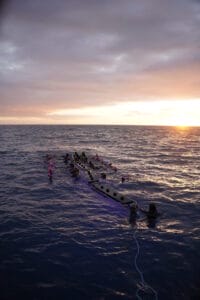Here’s another good article by the folks at NOAA Fisheries on the Spinner Dolphin. Sea Paradise Sailing and Snorkel offers morning and afternoon snorkel tours where you can often see these beautiful dolphins.
About the Species
Spinner dolphins are probably the most frequently encountered cetacean in nearshore waters of the Pacific Islands Region. Spinner dolphins received their common name because they are often seen leaping and spinning out of the water. The species’ name, longirostris, is Latin for “long beak,” referring to their slender shaped beak or rostrum.
Regarded as one of the most acrobatic of dolphins, spinner dolphins are well known for their habit of leaping from the water and spinning up to seven times in the air before falling back into the water. Experts believe that spinner dolphins use these behaviors primarily for acoustic signaling or communication, but the activity can also be a way to remove ectoparasites, such as remoras.
Appearance
Spinner dolphins are relatively small compared with other species of oceanic dolphins. They are slender, with thin, recurved flippers, and dorsal fins that usually range from slightly curved to erect and triangular. Among Gray’s spinner dolphins (the subspecies that includes Hawaiian spinner dolphins), adult females are 4.6 to 6.7 feet long and adult males are 5.2 to 6.8 feet long. They reach weights of at least 181 pounds. There is a great deal of color variation in spinner dolphins across the globe, depending on the region and subspecies of dolphin. Gray’s spinner dolphins exhibit a tripartite color pattern with counter shading from dark to light. The three-part color region consists of a dark gray dorsal/back cape, a light gray side, and a white belly.
Individual dolphins are identified by their unique dorsal fins. Researchers take photographs of the dolphins’ dorsal fins and then match the shape, nicks, and notches in each fin to a catalog of known individuals to obtain life history information for each animal.
Behavior and Diet
Spinner dolphins feed at night on species including small fish, shrimp, and squid that are found about 650 to 1,000 feet below the surface of the water. Spinner dolphin prey species follow a vertical and horizontal migration pattern, staying in deep waters in the ocean during the day, and then moving up in the water column (vertical migration) and inshore (horizontal migration) at night. Spinner dolphins take advantage of the nightly migration that brings their prey species to shallower depths and closer to shore by feeding throughout the night.
When resting, spinner dolphins move back and forth slowly as a single unit, with the animals in tight formation but spaced just out of contact with one another. They may engage in resting behaviors for about four to five hours daily. This behavior may vary seasonally, coinciding with the shifts in day length. During rest, spinner dolphins rely on vision rather than echolocation for scanning their environment. Group movements during rest are typically in open, sandy-bottom areas where predators are more visible.
At the end of their rest period, spinner dolphins usually abruptly increase their activity level, including their swim speeds, aerial behaviors, vocalizations, and make shorter dives than when resting. In 1994, researchers described spinner dolphins swimming in a “zig-zag” pattern following their rest period. They swam toward the open waters and then doubled back into shallower waters. This back-and-forth swimming repeats a zig-zag formation over most of the area, possibly functioning as a social cue for the entire group to coordinate their movement into the deeper seas. Likewise, the dolphins’ acoustic behaviors rise and fall synchronously with the zig-zag swimming patterns. When these patterns subside, the spinner dolphins swiftly race to the offshore waters of their foraging grounds, where they are sometimes joined by bottlenose or spotted dolphins. At this point, spinner dolphins’ dive times are extended and the dolphins begin their foraging movements.
Where They Live
Habitat
In most places, spinner dolphins are found in areas of deep waters where they likely track prey. Although the pelagic stock of Hawaiian spinner dolphins are found in the deeper waters offshore of the islands, the rest of the Hawaiʻi population has a more coastal distribution. During daytime hours, the island-associated stocks of Hawaiian spinner dolphins seek sanctuary in nearshore waters, where they return to certain areas to socialize, rest, and nurture their young. These areas are typically in clear, calm, and relatively shallow waters. They usually have a sandy bottom that presumably provides an environment in which the dolphins are able to visually monitor for predators, as they cease echolocation while they rest. Spinner dolphins use a variety of bays and nearshore coastal waters throughout their range, but they seem to prefer certain bays.
Distribution
Spinner dolphins are found throughout the world in tropical and warm-temperate waters. Four subspecies of spinner dolphins have been described worldwide:
- Stenella longirostris longirostris (also known as Gray’s spinner dolphin)—which includes the Hawaiian spinner dolphin—in the tropical Atlantic, Indian, and western and central Pacific Oceans.
- S. l. orientalis in the eastern tropical Pacific Ocean
- S. l. centroamericana near Central America
- S. l. rosiventris, the dwarf spinner dolphin, in southeast Asia to northern Australia
The Gray’s spinner dolphin is the typical form of spinner dolphin found in most areas of the world.
Lifespan & Reproduction
Like all marine mammals, spinner dolphins are slow reproducers. They live for about 20 years, with some individuals living for at least 25 years. Spinner dolphins may mate year-round, with multiple males mating with one female. Gestation is similar to other dolphin species and lasts approximately 11 months. Spinner dolphins calve year-round, generally about once every 3 years, and lactate often for 1 to 2 years. They reach sexual maturity at around 7 years of age.















